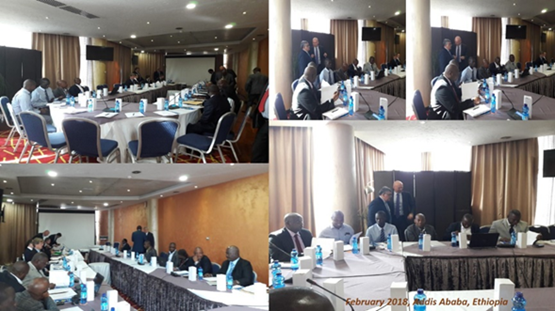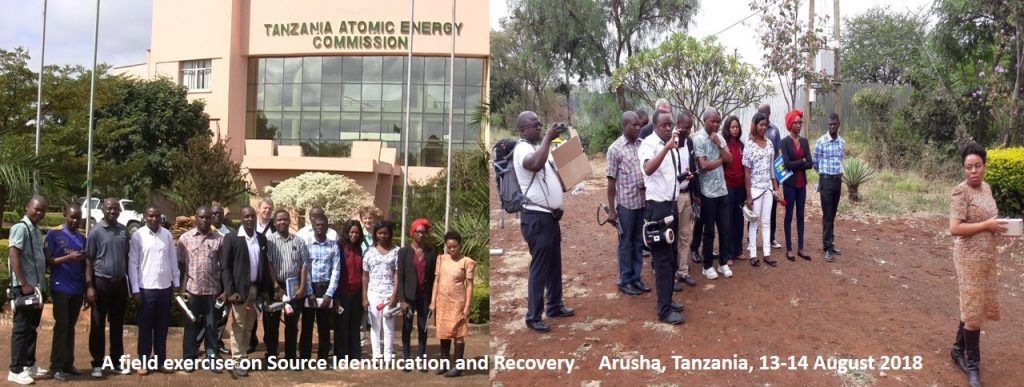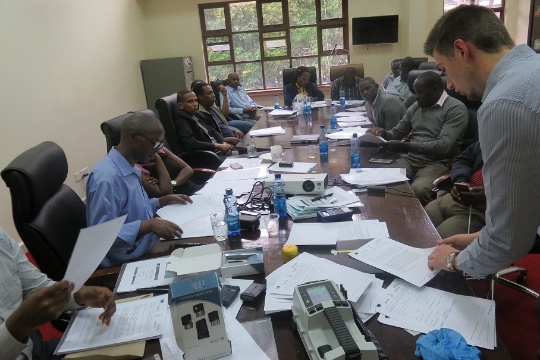At mid-point of its implementation, Project 60 reaches out to more experts in nuclear safety and security in all eleven participating countries-members of the EU CBRN Center of Excellence in Eastern and Central Africa.
Project 60 kicked off 2018 activities at a meeting in Addis Ababa
Thirty-two national representatives from the P 60 participating countries gathered for a technical meeting and training in Addis Ababa in February 2018. Representatives from the International Science and Technology Center (ISTC) and EC DEVCO provided overview and details about the regional and thematic context that shapes the specific project’s goals and activities.

The meeting’s participants touched on the existing legislative frameworks, inventory and regulatory control of RN material and the national emergency plans and contingency plans for RN incidents. A team of international experts led a three-day training workshop themed “Cradle to grave control of radiological material”. It introduced the IAEA’s Code of Conduct, standards and guidance, as well as the EU directives and best practices on control of radioactive sources. The participating countries highlighted their national arrangements and experience and elaborated on the national and regional challenges related with radioactive sources.
Project 60 featured in Geneva during the preparations for the 2020 Review Conference of the Parties to the NPT
Prof. Geoffrey Emi-Reynolds, a member of the Ghana National CBRN Team and former director general of Ghana Atomic Energy Commission, participated in April at an event, convened by the EU Delegation to the United Nations in Geneva and dedicated to the management of the full-life cycle of radioactive sources. In line with the event’s main theme “Benefits of the NPT: international cooperation in radioactive sources throughout their lifecycle”, prof. Emy-Reynolds spoke about Ghana’s positive experiences from participating in the EU CBRN Centres of Excellence Initiative and in particular in the Project 60. He participated at the panel discussion together with representatives from the European Commission’s Joint Research Center, the EU Delegation to the UN in Vienna, the IAEA, and the French Nuclear Safety Authority.
A series of workshops and field exercises

A field exercise on Radioactive Source Identification and Recovery was conducted at the national radioactive waste management facility in Addis Ababa on 16 and 17 August 2018. Three facilitators of the ENCO/SCK-CEN Consortium guided the fifteen participants from three project countries – Ethiopia (host), Uganda and Ghana. On day one, they discussed radiation physics and protection, equipment and different phases of search, identification, characterization and recovery. The staff of the Ethiopian Radiation Protection Authority (ERPA) made presentations on specific equipment available to them. On the second day, the participants exercised in two groups of five-six people with different roles (field officers with PPE and equipment, communication officers and radiological assessors) under the leadership of the consultants. During the debriefing, all participants enthusiastically expressed their willingness to apply soon in their countries the knowledge they received.
“Scenario: HIDDEN RADIOLOGICAL EXPOSURE DEVICE”
“A local physician warned the law enforcement organization: he examined several patients, who seemed to be suffering from radiation syndrome: drop of blood cells, vomiting… All patients had one feature in common: they all went to the same public place. It was suspected that a radioactive source was present in this place, therefore the area was evacuated and the entries have been cordoned off. The aim is thus to search whether radioactive sources are present in the public place and if radioactive sources would be found, to identify, characterize and recover them.”
Field exercises form an important part of Project 60 activities. This is the scenario received by representatives from respective national radiation protection authorities and nuclear safety -responsible institutions who took part in field exercises in Arusha, Tanzania; Nairobi, Kenya; and in Addis Ababa, Ethiopia, on the topic: “Radioactive source identification and recovery”.
Members of the Project’s Steering Committee decided to plan field exercises and table-top exercises in various formats in a broad spectrum of topics.

Fourteen participants from three partner countries – Kenya (host), Rwanda and Seychelles – took part in the field exercise on Radioactive Source Search, Identification and Recovery convened at the new National Radioactive Waste Management Facility near Nairobi on 27-28 August 2018. The Kenyan Radiation Protection Board (RPB) extended support in relation to operation of radiation monitoring instruments and technical arrangements. All participants obtained hands-on experience with personal protection equipment and various detection and identification/characterization devices, but also with techniques and standard operation procedures (SOPs). The participants, highly positive about the lessons learned during the field exercise, shared their ideas on how to improve the conducting of the search,identification/characterization and recovery of radioactive sources.

The Regional Workshop on Emergency Response Plans took place in Nairobi from 31 July to 3 August 2018.
The representatives of the partner countries shared insights on the progress in the development of their national emergency response plans for radiological incidents. They emphasized the correlation of these plans with the national all-hazards and/or CBRN response plans. It transpired that most project countries have drafts of their national Radiological Response Plans, developed to a different stage of completeness. Unfortunately, most of the national plans seem to be focused on the response to radiological safety events (e.g. malfunction, accident) but not on security related events (e.g. a radiological dispersion device – RDD and similar). While in some cases the response and recovery activities might be comparable, this is not the case in all events. Keeping in mind that none of the emergency response plans could be implemented without the appropriate standard operating procedures describing in details the practical implementation of the emergency plans, the experts from ENCO devoted some discussions specifically on this theme.
The second day of the workshop was dedicated to presentations on the contents and coordination of the national all-hazards, CBRN and radiological emergency response plans. At present, in only two partner countries (where the CBRN response plans were developed and approved in the frame of the CoE Project 17), the Radiological Response Plans are logically coordinated with the CBRN response plans. In the other countries, there are no CBRN response plan yet.
During the last two days of the workshop, the participants were guided in performing the gap analysis of their national Radiological Response Plans, using the criteria defined by the Outlines of a Generic Radiological Response Plan prepared by ENCO. The Outlines reflect the requirements to the radiological emergency response as established in the IAEA guides and standards and in good EU/international practices. The structure of the Generic Outlines ensures coordination and interfaces with the all hazards/CBRN response plans.
The representatives of the countries without draft Radiological Response Plans at the time of the workshop were guided in the preparation of initial drafts, using the Generic Outlines. This approach was selected to speed up the drafting process and get visible practical results by the end of the project. The workshop participants were therefore selected in a way to assure that (some) background knowledge and involvement in the development of the national response plans was already available. Upon return to their home countries, the participants will continue the development, eventually resulting in advanced drafts of national Radiological Response Plans. It was agreed that during the next expert missions to the partner countries, ENCO experts will review the draft radiological response plans and advise on their completions.
The regional workshop was organized by the Project 60 Contractor – ENCO, with support from the Kenyan National Focal Point, Kenyan organizations participating in the P 60 as well as the CBRN Center of Excellence Regional Secretariat, the Head of the Secretariat and the Regional coordinator.
Project 60 Steering Committee considers Next Steps
As the project enters a most decisive and dynamic phase, its Steering Committee met to discuss progress and to plan future steps. On 22 June 2018 in Brussels, National Focal Points and radiological and nuclear (RN) experts from P-60 participating countries were joined by representatives of the project’s managing and implementing partners: the European Commission’s DEVCO and Joint Research Center, UNICRI, ISTC, the Secretariat of the CBRN ECA CoE, as well as by representatives of the Consortium, contracted to carry out the project’s trainings, expert missions, consultancies and country reports. The Steering Committee ● took note of the decision to extend the duration of the implementation period of Project 60 until the end of March 2020; ● welcomed and approved the inclusion of Ethiopia as a P-60 participating state; ● underlined the importance of the delivery of the needed equipment to the participating countries and decided to continue to examine the possibilities in that regard; ● took note of the progress reports by ISTC and by the Consortium, led by ENCO and provided guidance on further reporting and activities; ● accepted the proposal by Zambia to host a public awareness event under Project 60.
Expert missions to project countries
aim to prepare national reports on management of radioactive sources, as well as assessments of the specific equipment needs – a question of primary importance to the participating countries. From April to September 2018, initial reviews took place during expert missions to examine the national capabilities to address safe and secure handling and storage of radiological sources, and orphan sources and seized materials in Rwanda, Kenya, Ethiopia, Seychelles, Tanzania, Uganda, Malawi, Burundi, DRC, and Ghana. The round of expert visits was completed in Zambia with a five days mission that commenced on 3 September 2018. The National CBRN Team, led by the National Focal Point Mr. Noble Mulenga, included representatives of various institutions, ranging from the MFA – in charge of the implementation of UNSCR 1450, officers from the General Staff and Defence, the Police, the Ministry of Health and Environment, Inspectorate of the Interior, etc. The process of authorization of the use of the RN materials came under scrutiny, as well as the need of regular and unannounced on-site inspections. The leading RN specialist Vladimir Ruhlo from the ENCO/STUK/SCK-SEN Consortium shared with the participants his experience in that regard from the IAEA division of nuclear security. Currently, the Zambian Parliament considers amendments, pertaining to the nuclear safety and security. In Zambia, the Radiation Protection Authority (RPA) has established stringent control over the circulation of RN sources, and the temporary disposal facility. The ENCO team visited also the storage of radioactive waste managed by Misenge Environmental and Technical Services. On 30 August, its CEO Mr. Joseph Makumba presented the functioning of the facility to the participants of the Conference on Enhancing Africa’s Capacity in Nuclear Safety, Security and Safeguard, organized in Lusaka by the RPA and ISTC.

Project 60: “Support to the EU CBRN Centre of Excellence for Central and Eastern Africa in Nuclear Security” is implemented by the International Science and Technology Center (ISTC). The project’s sub-contractor is an international consortium between ENCO (a Vienna-based engineering and management consultancy with expertise in the field of nuclear safety, nuclear operation and technical support), STUK (The Radiation and Nuclear Safety Authority tasked with nuclear safety and radiation monitoring in Finland), and SCK-SEN (the Belgian Nuclear Research Centre). The following countries, belonging to the EU CBRN Eastern and Central Africa (ECA) Centre of Excellence, participate in Project 60: Burundi, Democratic Republic of Congo, Ethiopia, Ghana, Kenya, Malawi, Rwanda, the Seychelles, Tanzania, Uganda, and Zambia.


©

